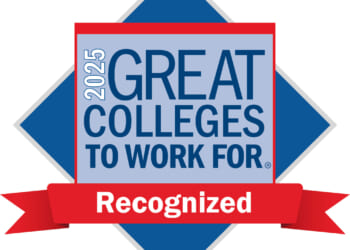Margaret Coker is in mid-rant. The editor of The Current in Georgia can’t believe the state tried to keep quiet a program to help single mothers pay for child care while they study for health aide careers.
“She never even heard of the program!” Ms. Coker boils, barely breaking stride for a visitor as she relates an interview from that morning with a worker trying to help the mothers. “I told her about it!”
Outrage fuels the co-founder of The Current, a five-year-old nonprofit news site she launched after a career at big papers. The staff regularly produces tough, probing stories that cut through the spell of coastal Georgia’s southern comfort.
Why We Wrote This
One in 3 U.S. counties no longer has a single full-time reporter, depriving communities of a reliable mirror. Meet Margaret Coker and the other journalists fighting to keep local news alive.
They have exposed a system of predatory lending in the state, called out sheriffs making millions of dollars by charging for phone and video calls by their jail detainees, exposed health and operating violations in an immigrant holding center, and dogged police misconduct cases. They questioned the accuracy of drug tests used in child custody cases, and revealed how the state paid millions to promote a program that kept eligible Georgians off Medicaid rolls. And they have earned, they say, 55,000 regular readers in text, newsletters, and online.
“There’s plenty of pent-up demand” for these stories, Ms. Coker says. “It’s not because we vote Democrat or Republican. … It’s because we live here and we want a better society.”
The headlines have been grimly relentless: Local news reporting is disappearing from large swaths of America. Small papers are closing. On Thursday, for example, News Media Corp. ceased operations, shuttering about two dozen weekly newspapers in five states. Others limp along, their newsrooms starved of staff, the familiar reporters at city councils and town events now gone, the community largely deprived of a reliable mirror. A recent data analysis found 1 in 3 U.S. counties do not have the equivalent of a single full-time reporter.
But as traditional sources of news crumble, there is Ms. Coker and hundreds of others like her who are keeping journalism alive. Many run small, online startups – often nonprofit efforts with little money and few staff, putting their reporting on the web or in texts or newsletters or social media.
They are the four-person Tennessee Lookout delving into murky legislation rolling back regulation on roughly half of the state’s wetlands, uncovering profits that the bill’s sponsor stood to make.
They are the 4-year-old New Bedford Light detailing how local fishermen are in the grip of foreign investors, or showing Immigration and Customs Enforcement agents smashing a car window while making a warrantless arrest. That was followed by executive editor Karen Bordeleau’s vow that, “No immigrant is going to disappear off the streets of New Bedford without the public knowing about it.”
They are Conecta Arizona, which started as a WhatsApp group during the COVID-19 pandemic and grew on a shoestring budget to offer Spanish-language news to immigrants via podcast, web, and text message.
They are the Boulder Reporting Lab’s months of investigation, led by graduate students at the University of Colorado Boulder, into a local coal plant’s unregulated water pollution.
They are innovating: training citizens to report on meetings, using texts or Instagram or TikTok to distribute their news. They are partnering with journalism schools, they are – like The Current – using artificial intelligence to compile a popular list of government meetings not available anywhere else, or to examine the worker injury rate at the new car plant nearby.
And they are growing.
Explosion of nonprofit newsrooms
“There’s an explosion with the nonprofit model,” says Karen Rundlet, executive director of the Institute for Nonprofit News, which began in 2009 with 27 news outlets interested in investigative news. The INN now has just over 500 members. Those newsrooms have produced a torrent of stories: More than 26,000 of their stories have been reprinted or rebroadcast elsewhere, says Ms. Rundlet.
Some outlets have matured into thriving newsrooms. The Texas Tribune launched in 2009 and now has a staff that includes 18 full-time reporters. CalMatters started in 2015 and lists 31 reporters throughout California. Inside Climate, based in Washington, has won a Pulitzer Prize with a reporting staff of 22. The Marshall Project, which launched in 2014 to cover criminal justice, has 23 reporters in four cities. The VTDigger, started by one laid-off editor in 2009, now has 11 reporters and eight editors.
“I didn’t want to leave journalism,” after layoffs at Vermont papers left her jobless, says VTDigger founder Anne Galloway. “Coverage of the state was pretty thin, and we needed more in-depth and investigative reporting.” Creating the startup, which now produces tough investigative journalism, was consuming work: “My 15-year-old son learned to cook from YouTube.”
Startups often try to fill a slice of the growing news void. Some are issue oriented: climate or immigration or criminal justice. Others cover broader happenings in a place, as traditional newspapers did. Some are focused on communities – Black, rural, immigrant, or diaspora groups – that were largely overlooked by traditional newspapers. AfroLA bills itself as “Unapolgetic. Black.” 100 Days in Appalachia explains: “The national media has failed Appalachia.” Belt Magazine covers the Midwest Rustbelt “as an antidote to shallow, distorted representations of the region.”
“I think a lot of people in communities, especially struggling communities in big cities, hadn’t seen journalists in their communities unless something terrible happened there,” says Chris Krewson, executive director of LION Publishers – which focuses on local, independent, online news – offering financial training to 413 local newsrooms.
“By gosh, I’m going to do this”
That was the spark for Ms. Coker in coastal Georgia. She had traipsed around the world as a journalist for Cox newspapers and the Wall Street Journal – Russia, Turkey, Dubai – ending up as the Baghdad bureau chief for The New York Times. She left for Savannah to write a book, and then “I needed to figure out what to do.”
The answer came in tragedy. An unarmed Black jogger named Ahmaud Arbery was tracked by three white men and killed in nearby Brunswick, Georgia, on Feb. 23, 2020. The murder was quickly written off by police as a justified killing and dismissed with a short crime report by the local media. It triggered Ms. Coker’s outrage.
“For over 80 days, nobody knew the how’s or the why’s, because it was just a one-page police report,” she says. “That’s the vacuum of investigative public service journalism. There was none. I decided, by gosh, I’m going to do this.”
At the same time, Susan Catron found herself out of a job. She was the executive editor of the Savannah Morning News for 15 years. The paper, once the respected voice of Savannah, Georgia, had a news staff of 70 when she started in 2005. Then the family-owned paper was sold to the first of several chains – it is now owned by Gannett – that followed well-worn corporate paths of hollowing out the staff. By the time she left, Ms. Catron had a staff of four and reporters were selling their own plasma to earn enough to pay rent, she says.
Six months later, the two women launched The Current with pledges of $350,000 collected by a Savannah friend and restaurateur. One of their first stories was what Ms. Coker describes as a “pretty straight-ahead, explanatory piece” about Georgia’s campaign finance laws and key donors to an influential state representative.
Her establishment Savannah supporters “freaked out,” Ms. Coker says. “They did not like what we did.” She was told, “Margaret, we don’t want to tell you what to write. We just want to tell you what not to write.”
When Ms. Coker would not back down, the pledges disappeared. For the next year, the two women toiled without pay, gradually rebuilding finances with other donors and grants, and eventually starting to hire staff.
They started in quirky digs – the town museum let them work in a Pullman train car parked outside the museum. “It was cute, cozy, and the right price, but there was no running water,” says Ms. Coker.
Eventually, they moved to a shared gold-stucco building. It sits at the crossroads of a mostly-white neighborhood of brick homes, trees and Spanish moss on one side, and a mostly-black neighborhood of smaller clapboard houses on the other.
Today, they work with a staff of four full-time reporters, a part-time data reporter, a photographer, and a small handful of freelancers and interns. Intern Tyler Davis, a senior at American University, was excited to pore over police body-cam footage recently with the local prosecutor to understand why no charges were filed in the case. “We are encouraged to spend a while looking into the things that the other places aren’t covering,” adds fellow intern Lily Belle Poling, a junior at Yale University.
The growth of local news outlets has been nourished by national philanthropies such as the Knight Foundation, the MacArthur Foundation, the American Journalism Project, and Press Forward. Others, including LION, Poynter, and the INN, provide guidance and training. Report for America, co-founded by a former Boston Globe reporter, has raised foundation money to help pay and put 758 journalists into 429 newsrooms since 2017, most of them in smaller news organizations.
Such support, while vital, worries some who see it artificially – and temporarily – propping up newsrooms that cannot survive on their own.
“There’s just no way that any one national source can spread itself that thin to make a meaningful contribution in the thousands of places” that need local news, says Mr. Krewson of LION. His group advises newsrooms to try to develop a mix of finances, such as for-pay music events or speakers, finding fellowships for reporters, fundraising drives, and seeking larger gifts from local civic-spirited donors who see the value of having local news.
Others wonder about the reach of this movement. David Jackson was a Pulitzer finalist four times in 29 years at The Chicago Tribune, and won a Pulitzer at The Washington Post, before joining the seven-reporter Injustice Watch in Chicago. There, he has exposed out-of-line judges and helped uncover the financial exploitation of seniors. But he acknowledges even successful newsrooms like Injustice Watch command only a shadow of the large audiences that helped legacy newspapers unify a community.
The nonprofits, he says, “They’re doing the work. They’re doing great work.” But he adds, “they haven’t replaced what the legacy newsrooms enjoyed and earned in terms of readership and audience and subscriptions.”
The future will bring no “one-to-one” replacement of traditional news by local nonprofits and startups, predicts Kristen Hare, director of craft and local news at Poynter, a journalism institute in St. Petersburg, Florida. “I don’t think you can expect all of the facets of life that were covered by a traditional newspaper to be replaced by a shop that’s devoted to covering just immigration or just housing or just climate change. … It will be something different.”















